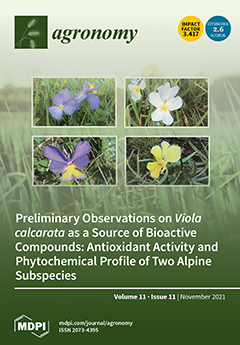The photosynthetically active radiation (PAR) of crop canopy is highly related to yield formation, but how it relates to yield and yield distribution is not well understood. The focus of this study was to explore the relationship between light competition under different densities and yield distributions of cotton. The experiment was conducted in 2019 and 2020 at the Cotton Research Institute of the Chinese Academy of Agricultural Sciences in Anyang city, Henan Province, China. A randomized block design was employed, with a total of three repeats. Each repeat had six density treatments: D1: 15,000; D2: 33,000; D3: 51,000; D4: 69,000; D5: 87,000; and D6: 105,000 plants·ha
−1. As predicted, the results showed that the canopy light interception, leaf area index, plant height, and biomass of high-density cotton were higher than those of low-density cotton. The aboveground biomass produced by D6 was the highest, and was 12.9, 19.5, 25.4, 46.3, and 69.2% higher in 2019 and 14.3, 19.9, 32.5, 53.7, and 109.9% higher in 2020 than D5, D4, D3, D2, and D1, respectively. Leaf area, plant height, biomass, boll number, and boll weight were significantly correlated with the light interception rate. D5 (87,000 plants·ha
−1) had a higher light interception rate and the highest yield. The highest lint yields produced by D5 were 1673.5 and 1375.4 kg·ha
−1 in two years, and was 3.2, 4.3, 5.6, 9.7, and 24.7% higher in 2019, and 6.8, 10.6, 13.5, 21.5, and 34.4% higher in 2020 than D6, D4, D3, D2, and D1, respectively. The boll retention of the lower fruit branch under D5 reached 0.51 and 0.57 in two years, respectively. The shedding rate of the upper fruit branch decreased with the increase in cotton density in two years. The boll retention rate and shedding rate in the lower part of cotton plants were most closely related to light interception, with R
2 values of 0.91 and 0.96, respectively. Our study shows cotton yield could be improved through higher light interception by optimizing planting density and canopy structure.
Full article





